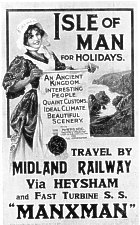
An enticing Picture Poster of the Heysham-Douglas Service.
BY G. A. SEKON.

An enticing Picture Poster of the Heysham-Douglas Service.
MONA'S Isle, Manxland, the Little Man Island, or by whatever other appellation we may choose to distinguish the Isle of Man, is the favourite pleasure and tourist resort of thousands of Englishmen. Nor need one be surprised at the favour with which the Island is regarded by those in search of health and pleasure. We will not, however, stop to expatiate upon the numerous advantages that are to be obtained by a visit to the Island, for the excellent Guide to the Isle of Man, issued by the Midland Railway, will at once convince those who peruse the brochure of the many charms of Mona. We are concerned with the ways of reaching this El Dorado of pleasure and health seekers. For many years the visitors to the Island had the choice of three routes, but recently the progressive Midland Railway has opened a fourth route via Heysham, hitherto only known as a salubrious suburb of Morecambe.
Readers of the RAILWAY MAGAZINE know that whatever the Midland Railway undertakes will be done thoroughly., and therefore it goes without saying that the arrangements for tourists and holiday makers patronising the Heysham route do Manxland are well planned and efficiently carried out.
The majority of English visitors to Mona's charming isle have in the past been drawn from Lancashire, Yorkshire and the Midlands, still there has always been a fair number of Londoners visiting the Island, but in the past the travelling arrangements between the Metropolis and the Little Man Island have scarcely been of the character to tempt the large numbers of travellers who are not particular as to where they spend their vacation, so long as the place possesses the usual characteristics of the pleasure and health resort. Armed with this knowledge the officers of the Midland Railway have entered upon an energetic campaign to attract Londoners to the Isle of Man, by providing a comfortable, conveniently-timed and swift service.
Passengers leave London (St. Pancras) at 8.30 a.m. each week day. The first stop of the Heysham Boat express is at Bedford,
which is reached at 9.27, and left two minutes later; then, after a halt at Kettering, the train diverges from the main
line at Glendon Junction, and travels via the Manton loop. A call is made at Melton Mowbray, and Nottingham, 123¼ miles
from St. Pancras, is reached at 11.2 a.m. After a stay of five minutes, the train proceeds on its journey northward, and,
travelling via Radford, at Trowell Junction (121 miles) joins the old route which runs via Trent, a call is made at Chesterfield,
and soon after the train runs into Sheffield. At the cutlery city passengers who have travelled by convenient connecting
trains from Birmingham, Derby, Leicester, etc., change into the Isle of Man Boat Special, which leaves Sheffield at 12.10
p.m., and, travelling at a high speed, reaches Heysham Harbour, 105 miles distant, at 2.30 p.m. The special has only made
a brief halt at Hellifield Junction, 70 miles from Sheffield, having avoided Leeds and Bradford and passed such important
gathering grounds for Isle of Man traffic as Normanton, Keighley, Shipley and Skipton en route. All these places, however,
besides many other towns in Yorkshire and Lancashire, are served by conveniently-timed trains connecting with the special
at Hellifield. At Settle Junction, the Midland line to Carlisle proceeds north-ward, and the Heysham train continues its
journey to the north-west, over a line incorporated years ago under the title of the North-Western Railway, but as an independent
company, spoken of as the Little North-Western, to distinguish if from the London and North-Western. The Midland Railway
absorbed this North-Western Railway many years ago, and the line is now wholly Midland.
[These were the times on the occasion of the inaugural trip in June; the July times are slightly different. See Time Tables.]
Londoners able to decipher the names of stations as the expresses rush through them will probably rub their eyes and think they have mis-read the nameboard of one of the stations, but no ! true enough they have passed Clapham Junction-needless to say it is not the Clapham Junction; although it is the Clapham Junction of the Midland Railway.
Alighting from the train at Heysham station, a short walk brings the traveller to the quay side, and there he sees towering above him the splendid turbine steamer Manxman, which is to convey him, at almost the speed of a fast train, to Douglas.
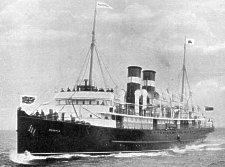
The Midland Railway's Turbine S.S. Manxman, engaged in the Heysham-Douglas
Service.
The RAILWAY MAGAZINE for October, 1904, contained an article descriptive of Heysham Harbour, so that it is unnecessary to say much concerning this colossal result of Midland Railway enterprise here, but the following brief details are of interest.
Heysham Harbour possesses the natural advantage of deep water at all states of the tide, and the Midland Railway's express trains from and to all parts arrive and depart alongside the steamers.
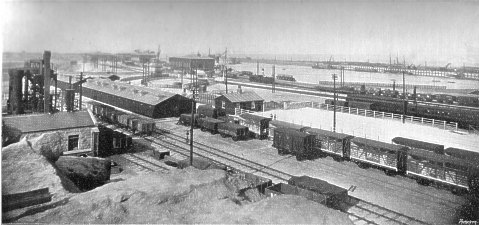
A Bird's eye View of Heysham Harbour
The north and south breakwaters are over a mile apart as they leave the land, and gradually converge until at the mouth of the harbour they are only 300 feet apart. The present equipment consists of a large quay, 3,000 feet in length, with a commodious passenger station along-side, enabling passengers to embark direct from train to ship and vice versa. Large goods sheds have been erected, along-side which the steamers berth. There is a depth of 17 feet in the harbour and 40 feet outside the entrance at low water ordinary spring tides, with landing facilities at all states of the tide. Every facility is provided for the convenient handling of horses, cattle, pigs, and geese, which are landed on sloping ways, and without slings. In order that cattle and geese after a heavy sea voyage may be able to rest and recover themselves before going forward by rail, large grazing paddocks adjoining the pens are provided. On the north side of the harbour is a quay for the berthing of coast-wise steamers carrying pig iron, iron ore, and other heavy traffic, with ample sidings for storage, and an extensive fish stage for unloading fish from steamers, trawlers and smacks by electric cranes.
It is the fashion to describe modern pleasure steamers as ' miniature liners'-this description cannot be applied to the Manxman, for she is a liner-and much more. In size alone she would have been a liner of a decade or so back, whilst the internal arrangements are on the lines of a down-to-date liner, but, excepting a few of the most recently constructed, she is in advance of the modern liner. Being propelled by turbine engines, the Manxman possesses great advantages, which travellers will at once appreciate. There is no reciprocating machinery, with its unpleasant vibration and noise; the steam does its work-and that more efficiently-by imparting direct rotatory motion to the screw shafts. A peep into the engine room of the steamer will at once impress even the most cursory observer with the advantages from a traveller's view point of the turbine system. Instead of a space crowded with giant cylinders, from which project massive piston-rods conveying by means of connecting rods, the motion to crank-shafts, the whole enveloped in partly condensed steam, pervaded by an unpleasant odour of damp heat and lubricating oil and with the deafening din and clank of the machinery, as it moves forward, then pauses and travels backward, to complete the discomfort of an engine room containing reciprocating machinery, we have a large, clean and lofty apartment, with plenty of unappropriated floor space. There are three large horizontal cylinders, but no moving machinery in sight, little vibration, less noise, no escaping steam, and no smell of lubricants. Yet the steam power is there, and is, moreover, well and economically employed. The Manxman has three screws, each independent of the others, and each capable of driving the ship at a good speed. In ordinary circumstances all are employed at the same time, hence the great speed attained by the Manxman. The central screw is actuated by the high pressure turbine, the drum of which makes 1,100 revolutions a minute, the steam being used at a pressure of 200 lbs. per square inch ; the low pressure turbine engines are on either side of the high pressure engine, and each actuates a screw shaft which makes 492 revolutions a minute.
Considering the steamer from the passenger's view point, we find the saloon accommodation is admidship and occupies about three-fifths of the vessel, third class passengers being provided for both in the stern and at the bows. She is 330 feet long and 43 feet beam. The accommodation consists almost entirely of large saloons, suggestive of the lounges and smoking rooms of a modern club rather than steamship apartments. There are also state rooms for night service when required, and a buffet from which refreshments are dispensed. There are three complete decks-the main,upper and promenade, whilst above the latter is a shade deck, which forms an unobstructed promenade. The dining saloon will seat about one hundred people, and the magnificent smoke room, with an arched roof 14 feet high, is fitted with all " the comforts conducive to contemplative peace."
The accommodation provided on the boat for third class passengers is equal to the second class accommodation usually allotted in cases of this kind.
A further word as to the sailing capacity of this new channel palace. The builders state that as a consequence of the usual enterprise of Messrs. Vickers, Sons & Maxim, Ltd., a higher steam pressure has been adopted than in any previous turbine ship, with the result that the exceptionally high speed got with this vessel is attained with a better economy than in other ship. The 23-knot (26½ miles) speed is obtained without any undue pressing of boilers or machinery.
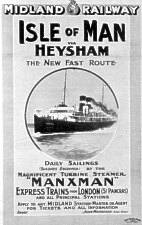
Another Picture Poster Issued by the Midland Railway
to advertise the Heysham Route to the Isle of Man.
Sixty-eight miles separate Heysham from Douglas, and since the Manxman is allowed 2 hrs. 40 mins. to perform the trip, it will be seen that she has something in reserve if she should be a few minutes late in commencing her voyage.
The boat is due at Douglas at 5.15 p.m., allowing visitors ample time to reach their hotels or apartments, and to dress, etc., before dinner.
So far we have described the usual week day service, but the Midland Railway this season proposes to run more than the one boat daily, for on Saturdays from July 14th to September 8th, tourists from London, as well as from the other towns served by the Midland Railway, will have an afternoon service to the Isle of Man. A supplementary boat will leave Heysham at 8.30 p.m., reaching Douglas at about 11.30 p.m.: the connecting express will leave St. Pancras at 1.30 p. m. There will also be a supplematary service daily from the Leeds and Bradford district from Saturday, July 14th, t o Monday, September 10th, arriving at Douglas at about 1 P.M. The Manxman leaves Douglas each morning (except Sundays) at 9.3 0 a.m., the boat train starts from Heysham Harbour station at 1.0 p.m., and calling at Cudworth, Sheffield, Nottingham, Kettering, and Wellingboro', is due at St. Pancras at 7.40 p.m.
On Mondays and Saturdays, from July 7th to September 17th, a train leaves Heysham Harbour station at 1.10 p.m., calling at Cudworth, Masboro', Nottingham, Kettering, and Wellingboro',reaching St.Pancras at 7.40 p.m.
For the convenience of holiday makers who desire to spend as much time as possible in Mona's Isle, a second service will be given from Douglas to London and the principal towns served by the Midland Railway, from July 14th to September 10th; the boat will leave Douglas at 3.30 p.m., reaching Heysham about 7.0 p.m., the connecting train leaving Heysham Harbour for Yorkshire at 7.35 p.m. An additional boat will also leave Douglas at 11.30 p.m. on Sundays from July 15th to September 16th, the connecting train reaching St. Pancras at 10.40 a.m.
The Midland Rail-way having made such excellent arrangements f or tourists desirous of visiting the Isle of Man, it remains with the latter to show their appreciation of the efforts made on their behalf by travelling to the Isle of Man via Heysham.
Douglas is, however, but the gate of Mona's Isle; true, many people stay in the town and spend their days in excursions to the numerous charming villages, and romantic glens in the island.
Many others proceed direct to Ramsey, a fine modern town, with a pleasure pier, nice sands, and other requisites of seaside resorts. Then there is the celebrated mountain, Snaefell, the summit of which is the Mecca of every visitor to the Little Man island, whilst who has not heard of Laxey and its world famous water-wheel some 72 ft. in diameter ?
These places are to the north of Douglas. To the south and west are to be found Castletown, Port St. Mary, Port Erin, the Tynwald Hill, Peel, and other equally interesting resorts.
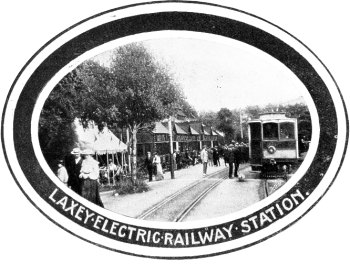
The way to reach the sights in the north of the Isle of Man is by the Manx Electric Railway. The Douglas terminus is at Derby Castle, and from thence runs a frequent service of electric trains to Ramsey, passing en route Groudle Glen, with its celebrated miniature railway; Garwick Glen; Laxey, with its mines, wheel, and famous pleasure gardens. Minorca (not the one mentioned in geography primers), where, in a prehistoric burial place, the Manx King Orry is said to be interred. Beyond this point natural glens, with water falls, flowers, and shrubs galore abound, and we pass in quick succession the Dhoonn Glen, Glen Mona, and Ballaglass Glen, and then run into Ramsey.
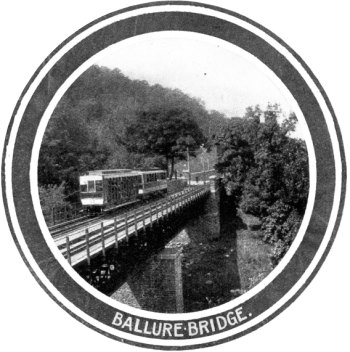
At Laxey visitors for Snaefell change cars, the railway to the summit of the mountain, which is 2,034 ft. above sea-level, branching from the Douglas-Ramsey line at this point. The ascent for the 42 miles to the summit being mostly at 1 in 12.
There is a safety centre rail, and as perfect, a system of brakes as can be devised, additional security-having been established during the past winter. A picturesque new hotel and waiting-room has been quite recently erected on the summit, and, as indicating the extraordinary popularity of the trip, it may be said that over 150,000 postcards were posted on the mountain-top last year. The catering is of exceptional character, and, as at the other main points on the line, is most efficiently controlled by Mr. R. M. Gardiner, the Manx Electric Railway Company's caterer.
Most people look upon electric railways as tramways, but the Manx Electric Railway is far from being a mere tramway. It has a double line throughout its course ; it has stations at which passengers must obtain their tickets; true, at some places, its track runs alongside the public roads, but most of the permanent way is laid on a course away from the thoroughfares. Substantial steel girder viaducts carry the line across valleys at points; parts of the line are in deep cuttings; guard rails are provided at sharp curves; whilst at level crossing, gatemen signal the trains with the conventional white, green, and red handflags ; the gradients (often as steep as 1 in 24), and the distances in miles (as well as ¼'s, ½'s, and ¾'s) are only shown on posts alongside the track. There are three types of passenger cars (closed and open motor coaches-fitted with the Christensen air brake -and open trailers) ; there are also open and closed goods vehicles, cattle wagons, and other types of rolling stock. In the busy season a train frequently consists of several vehicles. The length of the main line from Douglas to Ramsey is about 18 miles, and the branch. from Laxey to the summit of Snaefell is 4½ miles long. There are through bookings via the Electric Railway to Laxey and Ramsey from all the main line stations in England, and there is also full provision for the booking of luggage in advance to these points. Undertakings in the form of a granite quarry and a building-stone quarry certainly make the little line very unique and altogether interesting. Mr. Harold Brown is the energetic general manager of this extremely down-to-date electric railway, and visitors will find that every detail that makes for their convenience and comfort has careful attention at the hands of the management and staff. The fares are most reasonable, and passengers holding through tickets can break their journey at any station en route on the outward journey. In conclusion we may mention that their Majesties the King and Queen travelled by the Manx Electric Railway on August 25th, 1902. Every visitor to the Isle of Man should certainly do likewise.
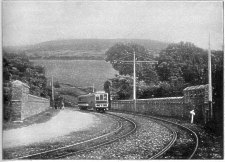
Manx Electric Railway's Train on the Bridge carrying the Railway over Groudle
Glen.
The various towns and pleasure resorts in the south and west of Little Manxland are reached by the excellent service of trains provided by the Isle of Man Railway, a go-ahead steam railway most efficiently managed by Mr. T Stowell. The line is constructed on the 3 ft. 6 in. gauge, and the 11½ miles, Douglas to Peel - right across the, Island-were opened for traffic 2nd July, 1873.
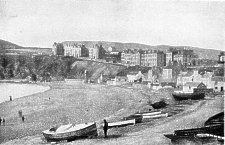
Port Erin, the Southern Terminus of the Isle of Man Railway.
The Southern line, Douglas to Port Erin, 15½ miles in length, was opened 1st August, 1874. The Manx Northern Railway (described in the RAILWAY MAGAZINE for July, 1899), was acquired by the Isle of Man Railway, 27th February, 1904. The railway possesses 15 locomotives, 98 passenger coaches, 16 brake vans, etc., and 114 goods vehicles. The return fares are remarkably cheap. To show the thoroughly down-to-date character of the Isle of Man Railway it may be mentioned that many of the passenger coaches are illumined by the electric light, on Sone's well known patent system.
The system of the Isle of Man Railway is easily understood by the most inexperienced tourist. As there are three " Legs of Man," so there are three main lines of railway, namely-the line running. from Douglas southwards to Castletown and Port Erin, that running west to St. John's and Peel ; and, lastly, the Manx Northern, running northwards from St. John's. There is also a short line running from St. John's to Foxdale. The Southern line has been increasingly popular in recent years. The rising importance of Port Erin and Port St. Mary, as summer resorts, have, doubtless, had much to do with bringing about this result ; but, besides this, visitors are appreciating more and more the fact that the most convenient access to all the southside scenery is by means of this limb of the Isle of Man Railway.
Journeying westward to Peel, we soon pass the platform at Kirk Braddan, to which trains run on Sundays for the convenience of people attending the services in the churchyard. St. John's is the station for Tynwald Hill (two minutes' walk), the ancient mound from which the Manx laws are promulgated on the 5th of July in each year.
Beyond St. John's is Peel, the terminus of the line, a delightful place.
|
|
||
|
|
||
| Any comments, errors or omissions gratefully received The
Editor HTML Transcription © F.Coakley , 2016 |
||